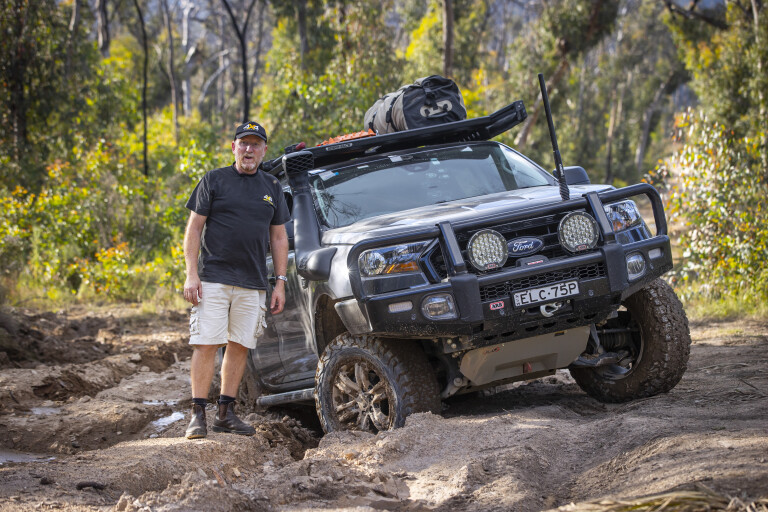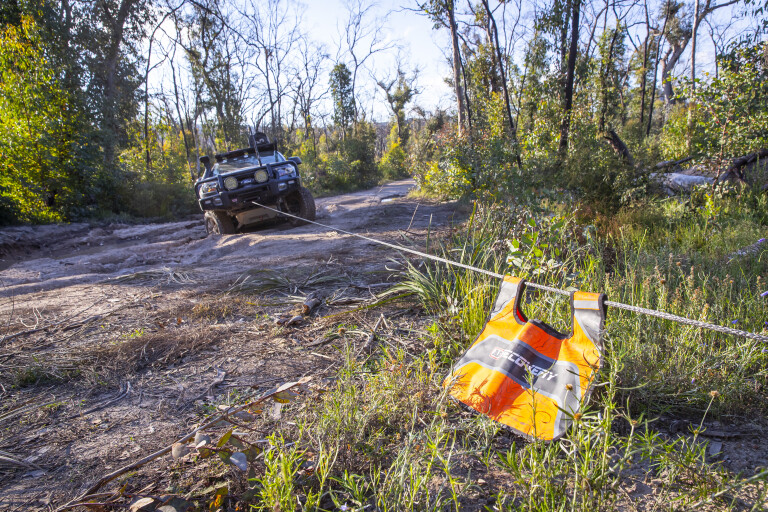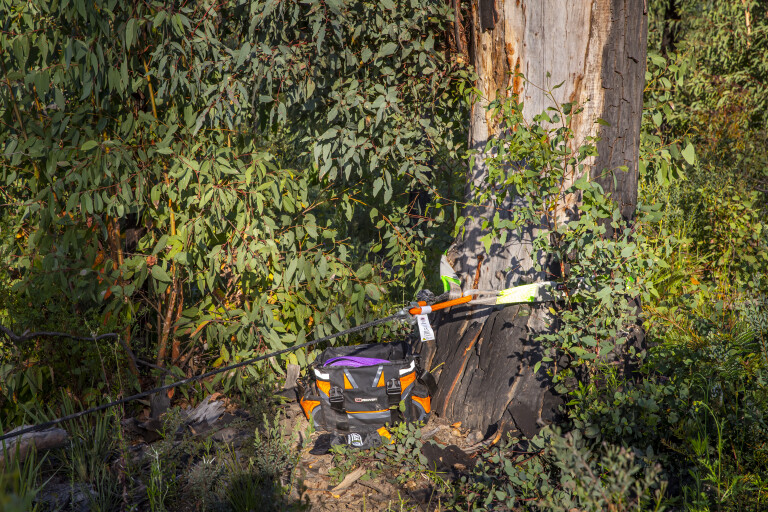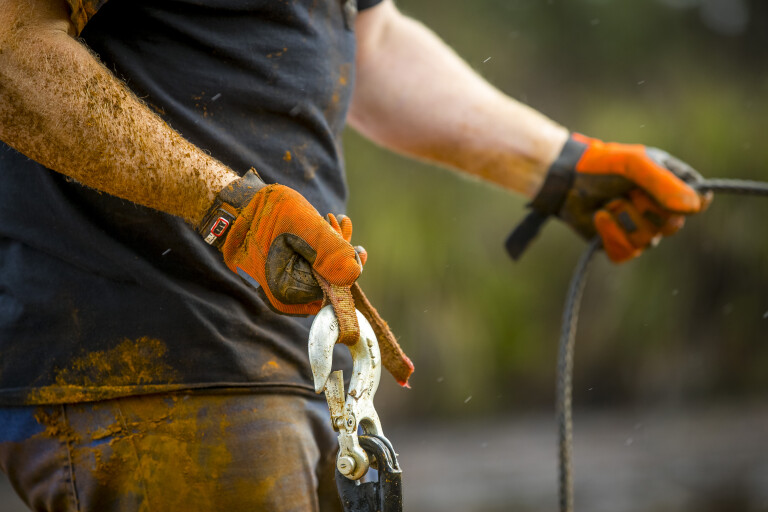
A vehicle-mounted electric winch is one of the most effective recovery tools available to four-wheel drivers, especially those who venture off the beaten track on their own.
As long as the winch is in operable condition, you have the right equipment on hand, and have a solid anchor point within reach, you should be able to perform a basic winch recovery. Here’s how…
The right winch
There are plenty of electric winches on the market, and before you slap down the hard-earned it’s important to know what one will best suit your vehicle.
Before looking at different winch brands, the first thing to figure out is what capacity winch you need to safely recover your vehicle should it become stuck. As a rule, it’s advisable that a winch should be rated to around one-and-a-half times the Gross Vehicle Mass (GVM) of the vehicle.
The GVM of my Ford Ranger, for example, is 3200kg, so it should ideally run a winch with a capacity in the vicinity of 4800kg (10,500lb). Bearing this in mind, I have fitted a 10,000lb Warn EVO 10-S winch.

Once you have calculated the capacity of the winch required, you’ll then need to look at other factors including gear ratio, line-pull speed and waterproof rating, as well as features such as how the controller connects (wired or wireless options) and whether it’s supplied with a steel cable or synthetic rope.
Most winches have a standardised mounting design, but you’ll still need to ensure that the winch you choose matches the winch cradle in your vehicle’s bar.
While there are plenty of budget-priced winches on the market, and some owners swear by them, when it comes to buying an electric winch, you don’t want to scrimp; after all, you need it to work when you really need it! Having said that, even the top brands can fail from time to time, so it’s important to regularly run the winch and to service it.
What else do you need?
A winch alone will not get you out of strife if you get stuck; you’ll also need a winch recovery kit. Here is a list of the gear you will need at a minimum: gloves; rated shackles; winch extension strap; tree-trunk protector; snatch block(s)/winch ring(s); and winch cable damper.

Other stuff that can come in handy for winch recoveries includes a shovel and a machete, the former for digging around the vehicle where it’s stuck or for clearing the track, and the latter in case you need to clear away scrub to reach a suitable anchor point..
You’ll also need to ensure your winch controller is handy and that if it’s a wireless model it has charged batteries.
Setting up a basic recovery
We’re going to focus here on a straightforward, single-line pull winch recovery; we’ll look at more complex winching techniques in a future issue, including double-line pulls and how to use snatch blocks to winch a vehicle sideways.
Once your vehicle is stuck and you have decided that using the winch will be the best recovery option, you’ll need to survey the situation and locate a suitable anchor point. If you’re in a wooded area, a substantial tree will likely be the ideal anchor point, but if you’re stuck in sand dunes or out in the open, you may have to use a sand anchor or even bury your spare wheel to use as an anchor point.
In the example pictured above, the vehicle is stuck in deep ruts on a muddy track, and it can’t be driven forwards or backwards. You could use a shovel to try and free the vehicle, or use recovery tracks to try to drive out, but with a big tree within reach right in front of the vehicle, using the winch will be the easiest extraction method.

The first thing to do is grab the winch recovery bag and pull out the gear that will be needed in the recovery, which in this case includes gloves, tree-trunk protector, soft shackle and winch-rope damper. The next thing to do is to connect the winch controller to the winch, which in this case is via a lead with a plug on the end.
There’s a clutch lever on the winch that needs to be moved to the free-spool position to pull out the required amount of winch rope. Make sure you’re wearing gloves when you grab hold of the winch hook and pull out the line as you walk towards the tree.
Once you have ascertained that the tree is strong enough to handle the weight of the vehicle recovery, run the tree-trunk protector around it and join the two looped ends using a rated shackle.

The tree-trunk protector should be positioned as low as possible around the tree as that is where it will be the strongest, and make sure there are no twists in the tree-trunk protector as it’s the width of this strap that prevents the tree from being ringbarked or otherwise damaged.
My preference is for soft shackles over steel D-shackles or bow shackles, as the heavy steel shackles can become lethal missiles in the event of an equipment failure. The winch hook can now be connected to the shackle.
As you walk back towards the vehicle, make sure the winch rope isn’t positioned where it could snag on obstacles, and bear in mind that rocks like sandstone can be abrasive to synthetic rope, so protect it where you can. Place the winch-rope damper over the rope at around the halfway mark between your vehicle and the anchor point.

Once back at the vehicle, shift the winch clutch lever back in to the engaged position. If on your own, you will need to operate the winch from inside the vehicle, so feed the cable for the controller over the bullbar and bonnet and through the driver’s window in such a way that it won’t slide off and fall under the vehicle while winching.
If there are other people around, you could enlist one of them to operate the winch controller from outside the vehicle, but there will always need to be a driver sitting in the driver’s seat during the vehicle recovery.
Make sure everyone is well clear of the recovery operation before starting the vehicle’s engine and then tension the winch rope by winding in via the controller. Electric winches draw a lot of current, so you will need to have the vehicle’s engine running so as to not drain the starting battery while winching. Once everyone is clear and the winch rope has been tensioned, you’re ready to start the recovery process. Note: never let anyone step over a tensioned winch rope; if it fails it could cause serious injury.

Before you start winching, make sure the vehicle is in low-range first gear, ensure the park brake is off and take your foot off the brake pedal; the vehicle will not roll backwards once the winch rope has been tensioned. Apply some throttle while winching in to take as much load off the winch as possible, but don’t drive too fast; you want some tension on the winch rope at all times so that it winds on to the drum evenly, and so you don’t run over it.
While winching in, keep an eye on the position of the winch rope damper. If it starts getting too close to the fairlead, you will need to reposition it closer to the anchor point. When doing this, remember not to step over the tensioned winch rope. If you need to winch over a long distance, make sure you give the winch a rest every couple of minutes so that it doesn’t overheat.
If the winch is straining, you may need to employ a double-line pull, but as mentioned we’ll get to that in another issue. However, if all goes well and you have successfully winched out of your stuck situation, you can stop winching and drive forward slightly to take the tension out of the winch rope.
This will make it safe to step over the rope if you need to, and will also make it easier to detach the winch hook from the shackle so you can retrieve the tree-trunk protector. Before getting out of the vehicle though, ensure the park brake is on and it’s in gear, or if it has an automatic transmission make sure Park is selected.
Packing up
You can now start packing away your gear. Make sure your gloves are on when handling recovery gear. Remove the winch-rope damper from the rope and then disconnect the winch hook from the shackle. Pack away the tree-trunk protector and then start winching in to feed the winch rope back on to the winch drum.
As you winch in, hold the winch rope to keep tension on it and feed it on to the drum as evenly as possible, starting from one side and moving across to the other, one rope width at a time, and then moving back across to the other side. This will prevent the rope from becoming tangled so it will be easier to spool out the next time you need to use it.

As the winch hook starts to get close to the fairlead, make sure you grab the hook itself and keep your fingers away from the fairlead. Take your time to finish off the job here and ensure there is just enough tension to keep the winch hook in place against the fairlead.
Finally, take a good look around the area to make sure you haven’t left anything behind such as a shackle or your tree-trunk protector, then pack away your winch controller.
When you get home
If you have used your winch in muddy conditions, you will need to clean the winch rope when you get the chance. If you leave it muddy, it will dry out and all the abrasive dirt and grit in there will damage the rope the next time you use it.
You should also check to make sure the winch rope is not tangled on the drum. If it is, spool it out and winch it back on to the drum evenly with some tension on it.
Check that your winch recovery kit is complete before you head bush again and, as mentioned, make sure you service your winch regularly.
Do
- Wear gloves when handling recovery equipment
- Run vehicle engine when winching
- Be smooth when winching in
- Wind winch cable/rope evenly on to the drum
- Maintain and service winch regularly and check operation
Don't
- Step over a tensioned winch cable/rope
- Allow spectators near recovery operation
- Overload winch (give it a rest every couple of minutes)
- Switch winch on and off constantly (it wears out solenoids)
- Get fingers near winch fairlead

COMMENTS